Choosing which college or university to enroll in is often an emotional and stressful time. Students are faced with tons of choices and must research vigorously to understand the benefits and drawbacks of their options.
They understand that their final pick can shape the next few years of their lives and beyond, further adding pressure to the process.
Therefore, it’s no surprise that students are looking for information to help them define their future.
Colleges would do well to ensure that students have the most relevant and comprehensive information they need to make a confident, well-informed decision about where to attend a higher-education institution.
Students often do research by using the internet, social media and other apps. By going digital, you can reach new audiences, increase lead generation, and ultimately increase applications, campus visits and enrolment. This guide will show you how.
The Impact of COVID-19 on Student Enrollment
COVID-19 has resulted in many students thinking about deferring their first or next semester to avoid starting college remotely.
A report by McKinsey found that if higher education institutions plan to use remote learning in the fall, 32% of students report that they’ll prioritize schools with better online capabilities, 29% would look for lower tuition and attendance fees and 25% would prefer institutions with helpful job-placement resources.
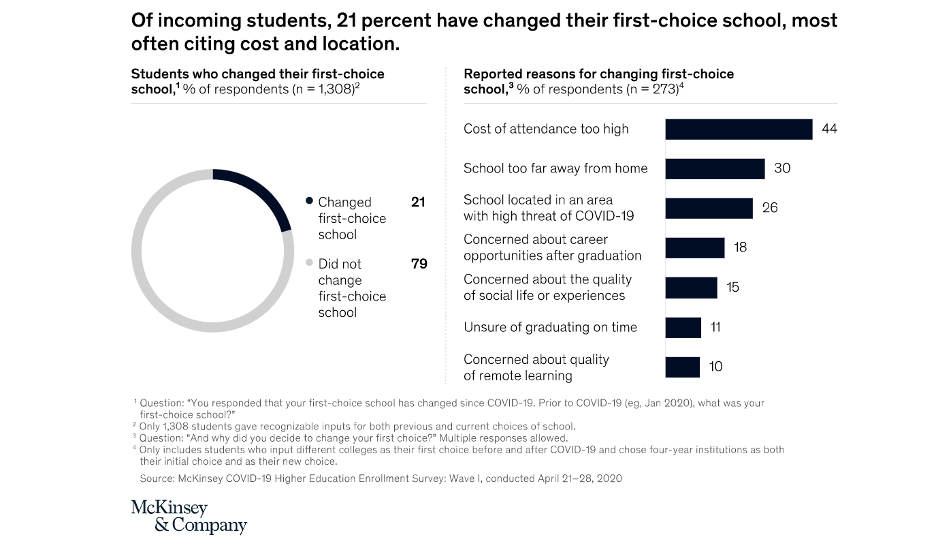
McKinsey’s research also suggests that if there is a remote fall semester, there may be up to a 15% drop for domestic first-year undergraduate enrollment.
That decrease, paired with a modest 5% drop in domestic non-first-year undergraduates, could lead to almost $7 billion in lost tuition and revenues for four-year higher education institutions in the United States. Understandably, 86% of college presidents are prioritizing enrollment numbers in response to stressors due to COVID-19.
Universities should use these coming months to understand and address students’ concerns, as well as explore their options for promoting their institution. The uncertain future will require colleges and universities to become adaptable and resilient in their approach to drive enrollment.
Digital marketing is a valuable way to make real-time, data-driven marketing decisions. This ability to change and pivot will be critical as the situation continues to evolve.
Developing a Full-Funnel Strategy
A full-funnel marketing strategy is the best way to nurture students through their journey from awareness to decision-making.
Here are the key stages you’ll need to include in your strategy to have a full-funnel approach to digital marketing.
Decide on Customer Personas and Targeting Options
Although it’s tempting to try to attract all students with every ad, it’s more effective to target one narrow, specific audience at a time. By targeting students who are among the most likely to enroll at your school, your campaigns can generate more high-quality leads per dollar spent.
To figure out who to target, you should define your ideal customer avatar or buyer persona. By creating a composite sketch of your target audience, you can identify patterns in their age, gender, location, personal interests, online search habits and more.
Using this information, you can create a good guess at what kind of ad might catch their attention as they browse websites and social media online. You can also research what search terms they lean towards as they browse universities. For example, “student clubs” or “science program” are search terms that a student might use.
Bring New Leads into Your Funnel with Programmatic Ads
With programmatic, you’ll be able to capture new leads in a targeted way. By using advanced audience targeting, you can expand your pool of new audiences and target lookalike audiences as well.
In this Acquisio case study, we worked with a client to aim for a target cost per acquisition (CPA) of $100. The goal was to target 18-24-year-old high school graduates with low- to moderate-income and an interest in education.
Thanks to programmatic, we could determine ad relevance by both day and time of the week. This allowed us to reduce unnecessary ad spend and optimize bids for higher conversions. The campaign resulted in cost savings of 41% below the target CPA, and our prospecting strategies yielded direct conversions.
Reaching Potential Registrants with Social Media
With social media advertising, schools can create highly targeted ads to increase organic reach. Unlike web page ads, social media ads are not targeted based on keywords, but instead on rich demographic and psychographic data collected about social media users.
Having detailed buyer personas is especially helpful for social media ads. Many social media platforms allow you to target users based on age, location, personal interests, education level, field of study, job title and a variety of other traits and characteristics.
Nearly 95% of adults aged between 18 and 34 follow brands through social networks. Therefore, placing ads on social media can bring students and their families into the school’s orbit. By targeting on social media, colleges can encourage prospective students to join related groups, forums or email lists where they can be nurtured further.
Close the Enrollment Loop with Paid Media
Strategically placed paid media can seal the deal with prospective students. By placing ads throughout key milestones during the college search process and designing creatives based on search intent, colleges and universities can position themselves at the perfect time and place.
Programmatic retargeting is an effective lower funnel strategy for prospective students. By placing a pixel on your site or landing page, you can follow site visitors to other places they visit across the web and systematically remind them to come back and enroll (or take another desired action). Programmatic retargeting is a great way to stay top-of-mind during important decision-making points for the student.
Paid search can place your website at the top of the Search Engine Results Page (SERP). This allows you to reach prospects who are already looking for educational programs. By targeting keywords that are towards the bottom of funnel (BOFU), you can reach students who are close to making a final decision.
Pairing paid search with programmatic retargeting is an effective way to both get in front of prospective students and stay top of mind.
Increasing Enrollment Numbers
To increase enrollment numbers, it’s important to target students at the right time and place. Here are the key ways to target students at important decision points to increase their likelihood of enrolling at your university.
Inquiries and Campus Visits
Programmatic ads are known for their unique ability to target specific audiences at the right time and place. For instance, you can combine contextual, keyword, location and other layers of programmatic data to bring new potential candidates into your funnel.
In this Acquisio case study, we worked with a client to drive cost-efficient registration conversions from across 14 U.S. cities for a variety of trade school programs. By using sophisticated programmatic tools like geofencing prospecting, bid adjustments, and programmatic ad formats, we were able to earn direct conversions all below the budgeted CPA.
Programmatic retargeting can help increase inquiries and campus visits by adjusting call-to-actions in real-time. For example, the primary CTA for a previous site visitor can be updated to promote campus visits, info sessions or application submission.
Undergraduate Lead Generation
Many prospective students like to interact and learn about colleges online. Because attending college is an inherently social activity, showing up on social platforms is a great way for universities to showcase their campus life, culture and activities.
Social media has a variety of options for ad promotion. Video and banner ads work well on Facebook and YouTube. Custom Instagram filters and stories are a great way to encourage user-generated content.
Here’s an example from Dartmouth College’s Instagram story that calls for user engagement.
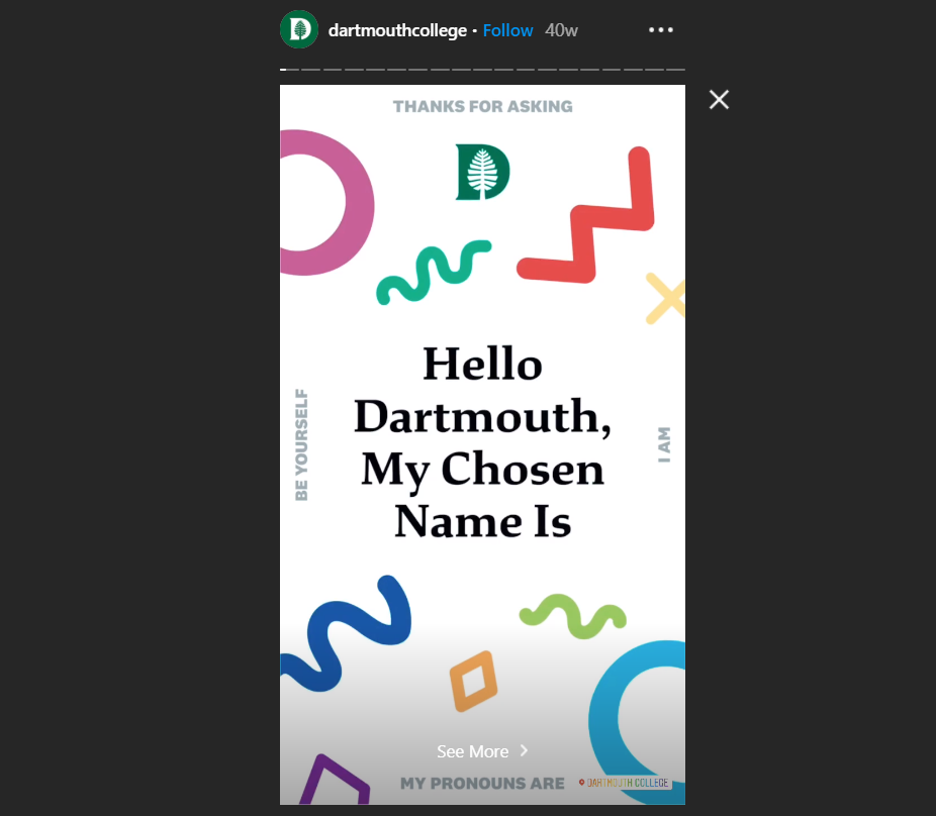
Student Applications
Programmatic retargeting is often leveraged to close the loop between viewing the application page and taking action.
With programmatic retargeting, you can see how a potential student interacts with the site, identify their intent and then use programmatic ad buying to respond to it in real-time. Overall, it gives marketers unparalleled audience targeting at scale.
Programmatic retargeting tools take full advantage of buyer intent data. This ability lets you customize the ads served to prospects based on the way they’ve interacted with your website. Remarketing can be used to reach all previous site visitors in the past few months with programmatic ads.
For example, if a student visits the application page to apply, but doesn’t complete the form, you can retarget them across the web with a display ad that reminds them of the upcoming application deadline.

Pulling it all together – Scheduling Out Your Campaign
These are the key marketing strategy milestones that you’ll want to target as prospective students move through their journey of choosing the right institution for them.
Previous Summer: May-August
By starting 12 months in advance, you can get on their list early and become a ‘benchmark’ against which other colleges and universities will be compared. Getting in front of prospective students early can help influence decision making.
At this stage, we’d recommend focusing on generating interest and awareness. For example, you could create video content that shares information about student life, study options and extracurriculars.
The priority should be collecting personal information that you can then use to contact them in the future as the process moves along. Email is ideal, but encouraging students to follow your school on social media is another good option.
Previous Fall: September – November
At this stage, focus on reaching applicants in a variety of locations. College students fall into three main categories: local, national and international.
Differentiate these categories based on your quotas, and design special creatives and unique messaging to set your campaign budget accordingly.
Winter and Spring: December – March
Leverage your first-party data collected from the summer to retarget visitors from your site. Take advantage of programmatic geotargeting to promote open houses and other student recruitment events.
Now is the time to shift your messaging to direct action. Use engaging ad copy and CTAs to call for applications, remind students of key deadlines and make a final call for campus visits and inquiries. Programmatic retargeting is key to closing the loop and securing applications.
Benefits of Each Potential Ad Platform
Each ad platform has its own advantages and drawbacks, and sometimes the best platform is no ‘platform’ at all.
Google Ads
With Google owning 92% of the search engine market share, running successful ads here has increasing your potential to reach your target audience.
Google Ads are often preferred for their high ROI, which they claim typically generates $8 for every $1 spent. Using Google is great for running programmatic display ads since you can also leverage YouTube, Google Maps, Google My Business, Gmail, and others.
higher-education-marketing-google-ppc-ad.png
Overall, because Google Ads is a competitive space, you’ll need to target long-tail keywords. This is recommended anyway so that you can reach targeted audiences.
If you’re considering social media advertising, Facebook is the best place to start. With Statista estimating 2.6 billion monthly active users in Q1 2020, Facebook is the biggest social network worldwide.
Part of what makes the platform so appealing to advertisers is the rich data Facebook has on its users. Facebook ads can be targeted by location, demographics, behavior, interests and Facebook friend connections. It also offers ads that target ‘lookalike audiences’, which are potential customers that share similar characteristics to your best existing customers.
Facebook ads can take a variety of formats including images, video and text. They can also appear in a variety of Facebook locations such as the news feed, marketplace, messenger, and stories.
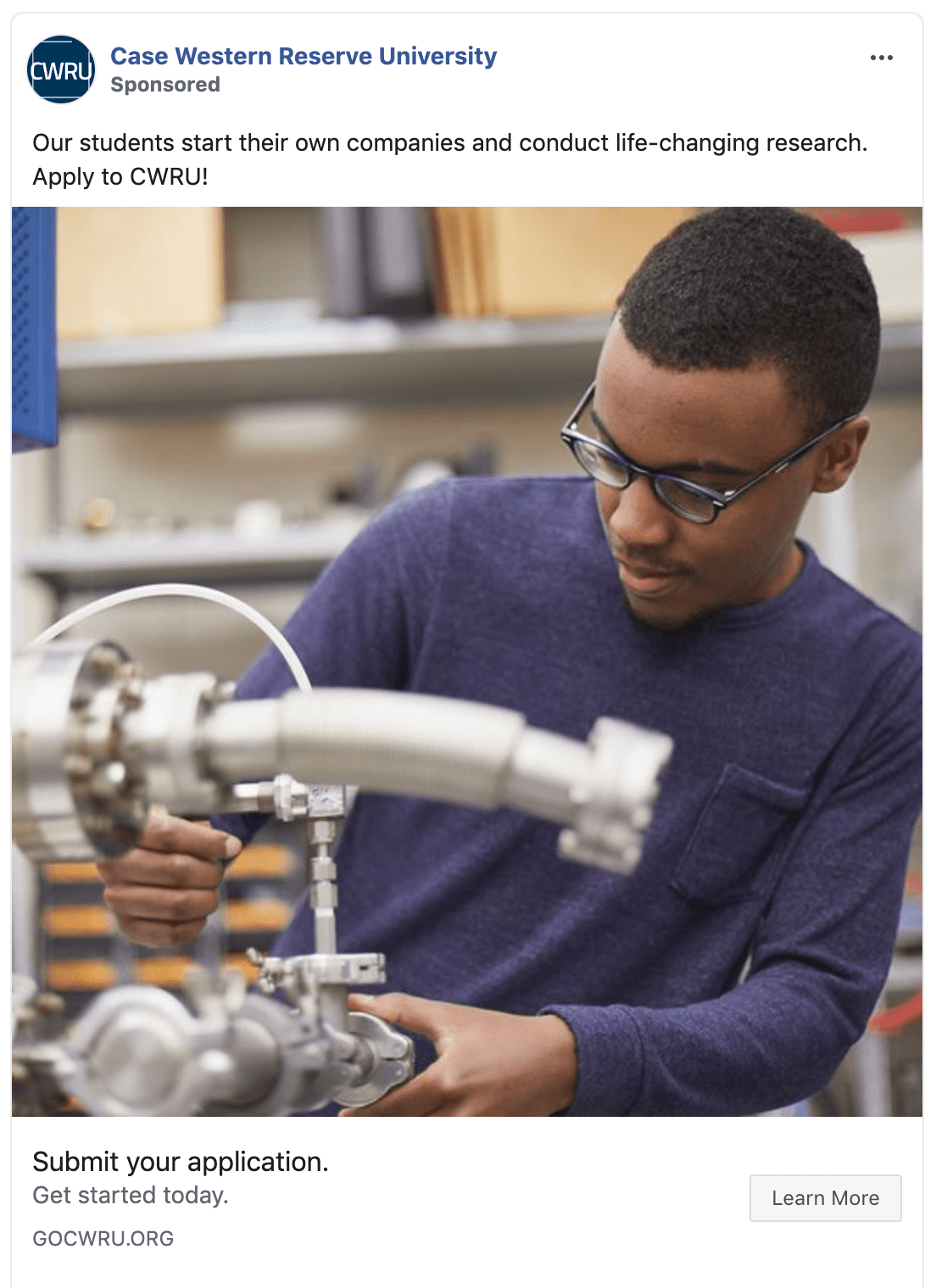
If you plan to run Facebook ads, Instagram could be easily added to your strategy. Because Instagram is owned by Facebook, marketers can use Facebook’s comprehensive ad manager to create Instagram ad campaigns and craft a multi-channel advertising strategy.
Instagram ads typically show up on the user’s feed or in stories, but you’ll have a variety of creatives to choose from. Instagram ads can be an image, video or a carousel post.
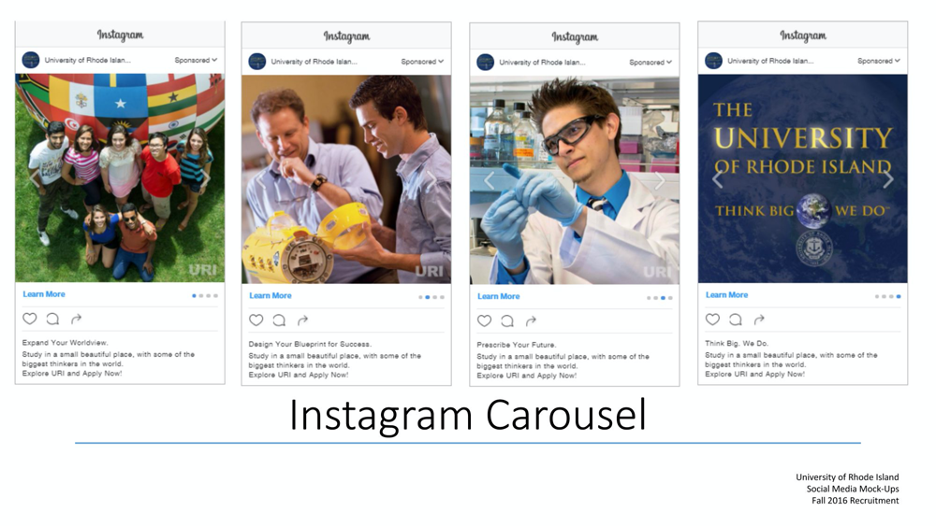
Instagram ads often see more engagement than Facebook Ads. A social media engagement study reported that brands earn a median engagement rate of 0.09% per Facebook post, whereas on Instagram they receive a 1.60% median engagement rate per post.
LinkedIn is the platform where people go to make professional connections, learn about career opportunities and share their personal success stories. Overall, it’s a great platform to focus on when trying to appeal to diligent and motivated students.
LinkedIn ads typically come in standard social media formats. A unique feature for LinkedIn is its Sponsored InMail option. InMail is LinkedIn’s version of messaging and a sponsored InMail is a message from a LinkedIn advertiser.
For example, when Duke University ran a LinkedIn advertising campaign, their Sponsored InMails earned an impressive 68% open rate and increased the closure of their sales pipeline by 300%.
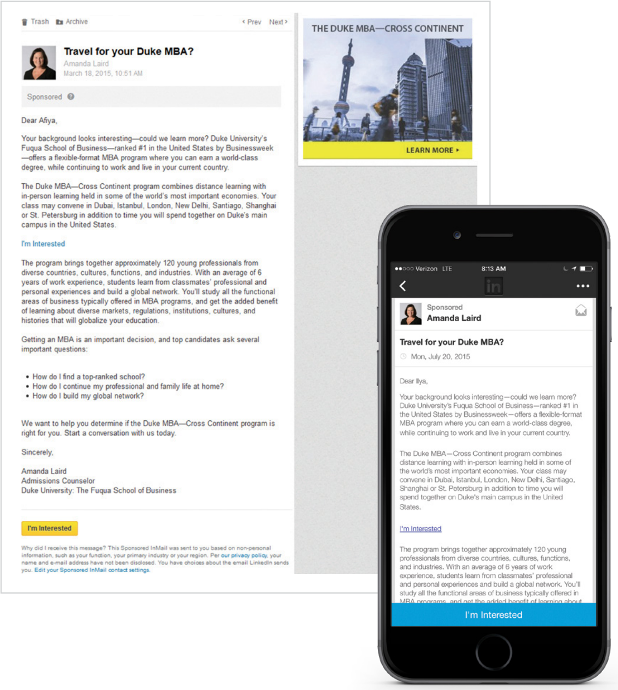
Many business schools and universities have found this type of ad highly effective.
The Open Internet
When we get caught up in using Google and social media, it’s easy to forget that the internet is a big place. There are many other opportunities for marketing outside of these channels. The open internet can be leveraged to run PPC and other ads wherever your audience spends time online.
A variety of websites, apps, and other platforms can host programmatic ads as well. By leveraging programmatic and the open internet, you can tweak campaigns in real-time, run cross-device campaigns, improve your ROI and reach your audience at the right time and place to optimize for conversions.
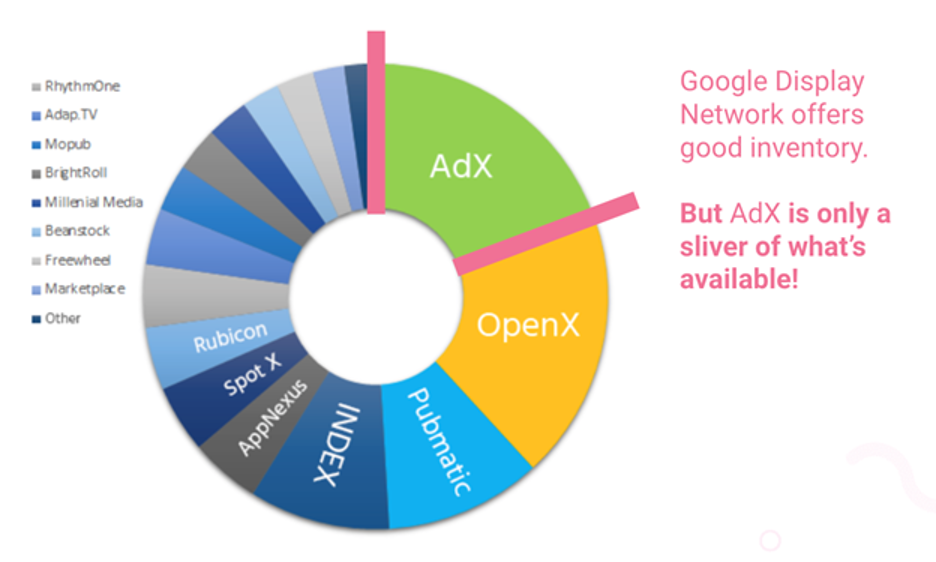
Three Examples of Successful Higher Education Marketing
Higher education advertising campaigns can be impactful and memorable when done right. Here are three examples of successful higher ed marketing campaigns done by universities across the US.
West Virginia University Students Share Their Daily College Life
West Virginia University (WVU) runs a vlog series on YouTube called “My WVU Life” that offers a peek at daily life at WVU. Current WVU students film their everyday college experiences. They share behind-the-scenes footage of campus dorms, WVU football games, and class experiences. They also offer fun commentary that helps prospective students feel like they’re getting a personal tour.
Video content is an easily digestible and shareable medium that is popular with today’s younger audiences. Creating a video series that communicates a key message and offers a snapshot of campus life allows you to make a meaningful and memorable connection with prospective students.
Augusta University Inspires Students to Feel Boundless
By creating targeted blogs, social media posts and videos, Augusta University aimed to inspire students with their #BeBoundless campaign.
In the campaign, Augusta University shared helpful tips on ways students can get involved in and out of the classroom, recommended popular hang-out spots in Augusta, and shared their take on what it means to “Be Boundless”.
The multichannel campaign both inspired prospective students and shared the key information they need to know about Augusta University. By reaching students on a variety of platforms, Augusta University increased its brand awareness and created an inviting and inspiring message for students to consider.
Appalachian State University Shows Off Their Beautiful Location and Campus Culture
Appalachian State University managed to highlight their beautiful location, student diversity, and engaging professors all in a 1-minute video ad.
By using an emotionally compelling mountain metaphor, the university shows that they help to create and attract capable, driven and confident students.
The ad captures the spirit and culture of the school while still staying specific about what it has to offer as an institution.
Conclusion
Overall, universities and marketers need to be conscious of the student journey. The college search is a stressful and life-changing time period with many key milestones along the way. The goal should be to target students with informative, timely and heart-felt campaigns that inform and support their research.
Programmatic marketing is uniquely suited to help you reach your target audience at the right time and place. By leveraging special capabilities like geofencing, real-time bid adjustments and the open internet, you can position your institution as a friendly guide that will help them achieve their full potential.
Ready to take your higher education campaign to new heights? Get in touch for a free Acquisio custom strategy session.
Image sources:
Image 1: McKinsey
Image 2: Dartmouth University
Image 3: London Metropolitan University
Image 4: Fremont University
Image 5: Case Western Reserve University
Image 6: University of Rhode Island
Image 7: Duke University
Image 8: Acquisio



